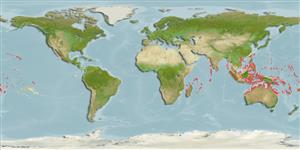Common names from other countries
Environment: milieu / climate zone / depth range / distribution range
Ecologia
marinhas associadas(os) a recifes; não migratória; intervalo de profundidade 0 - 20 m (Ref. 9710), usually 2 - 15 m (Ref. 37816). Tropical; 26°N - 25°S
Indo-Pacific: East Africa to Mangaréva, Tuamoto Islands and the Hawaiian Islands, north to Taiwan; throughout Micronesia.
Tamanho / Peso / Idade
Maturity: Lm ? range ? - ? cm
Max length : 8.5 cm SL macho/indeterminado; (Ref. 9710)
Espinhos dorsais (total): 10; Raios dorsais moles (total): 12; Espinhos anais 3; Raios anais moles: 6. Irregular dark bars on body which may be broken into spots; 2 narrow diagonal bars on cheek; opercle and base of soft dorsal with large ocellated black spot (Ref. 5469).
A secretive species remaining in or near interstices of rock, coral, or rubble (Ref. 2334, 58302). Moderately common in seaward reefs in areas exposed to moderate surge or currents (Ref. 2334). Feeds on small crustaceans (Ref. 89972). Benthic (Ref. 58302). Minimum depth reported from Ref. 30874.
Life cycle and mating behavior
Maturidade | Reprodução | Desova | Ovos | Fecundidade | Larvas
Randall, J.E., G.R. Allen and R.C. Steene, 1990. Fishes of the Great Barrier Reef and Coral Sea. University of Hawaii Press, Honolulu, Hawaii. 506 p. (Ref. 2334)
Categoria na Lista Vermelha da IUCN (Ref. 130435)
CITES (Ref. 128078)
Not Evaluated
Ameaça para o homem
Harmless
Utilização humana
Aquário: Espécies comerciais
Mais informação
Nomes comunsSinónimosMetabolismoPredadoresEcotoxicologiaReproduçãoMaturidadeDesovaFecundidadeOvosDesenvolvimento dos ovos
ReferênciasAquaculturaPerfil para aquaculturaEstirpesGenéticaElectrophoresesHereditariedadeDoençasProcessamentoMass conversion
Ferramentas
Relatórios especiais
Descarregue XML
Fontes da internet
Estimates based on models
Preferred temperature (Ref.
115969): 25.2 - 29.3, mean 28.4 (based on 2558 cells).
Phylogenetic diversity index (Ref.
82804): PD
50 = 0.5312 [Uniqueness, from 0.5 = low to 2.0 = high].
Bayesian length-weight: a=0.01585 (0.00637 - 0.03944), b=3.01 (2.79 - 3.23), in cm Total Length, based on LWR estimates for this (Sub)family-body shape (Ref.
93245).
Nível Trófico (Ref.
69278): 3.5 ±0.6 se; based on size and trophs of closest relatives
Fishing Vulnerability (Ref.
59153): Low vulnerability (10 of 100).
